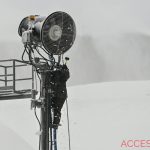Out for a walk on the snow-covered farm last week, I paused beside the meadow and felt an overwhelming sense of stillness.
Suddenly, things felt so insulated. So calm. So peaceful.
I closed my eyes and listened.
Whoosh…
Whoosh…
Whoosh…
A lone crow flapped its wings overhead.
For a brief moment, it felt like life was moving in slow motion.
I turned my gaze to the large stand of milkweed, goldenrod, aster and echinacea stems still standing in the meadow.
Long gone were the colors of spring, summer and fall, but their darkened, browned stems still serve a purpose.
Even without the chaotic, buzzing business of collecting warm-season nectar and pollen, many of our pollinators and other beneficial insects rely on dead stems and stalks and undisturbed leaf litter and soil to fulfill their life cycles.
One that’s easy to spot in the winter is the goldenrod gall fly. (It’s official name is Eurosta solidaginis.)
This fly is native to our area, meaning ecologically speaking, it belongs here and serves a purpose in keeping our landscapes healthy and balanced.
The monarch butterfly gets lots of attention for needing native milkweed plants to complete its life cycle. But there are hundreds and hundreds of other beneficial insects out there that also specialize and need a specific species of plant to live.
As you probably guessed, the goldenrod gall fly needs native goldenrod. In fact, this tephritid fly — smaller than a housefly — completes its entire life cycle only on goldenrod. (They are clumsy fliers, so they tend to hang very near the same goldenrod patch where their mama laid them as an egg.)
In the spring, a female gall fly lays eggs in goldenrod stems. In a few days, the larvae hatch out and start feeding on plant tissue inside of the stem. However, the baby “maggots’” saliva contains a compound that causes the goldenrod stem to start growing abnormally, creating a sphere or bubble in the stem that can grow to about the size of a golf ball. (Don’t worry, the plants will go on to bloom just fine.)
The larvae continue feeding on the inside of the stem, creating a cavity where they can overwinter. This time of year, it’s particularly easy to see this on goldenrod stems.
What’s really cool is how the insect adapts to survive through freezing temperatures. Inside the goldenrod stem, cold temperatures trigger each larva to convert glycogen into glycerol and sorbitol, creating its own version of antifreeze so ice doesn’t build up in their most internal parts. They are said to be able to survive temperatures as low as -31 degrees Fahrenheit!
And in just a few weeks — in early spring — this winter’s goldenrod gall flies will start to emerge as adults. And how they do it is pretty fun!
According to scientists, the flies contain a balloon-like structure in between their eyes that inflates to blast through the outer stem covering. It’s their very own built-in battering ram device!
Once all grown up and outside of the stem, these flies tend to move about by walking instead of flying, so they don’t cover much ground in their 10 to 14 days of remaining life.
During this two-week adult-life stage, males will put on their best dance moves to attract females, and females will then continue the life cycle by laying more eggs on nearby goldenrod plants.
Free bird food
Although many goldenrod gall flies survive, some become a meal for hungry birds or even other pollinators.
Some parasitic wasps and beetles feed on larvae, while black-capped chickadees and downy woodpeckers are masters of breaking into galls and feasting on the high-nutrient larvae inside.
So the next time you spot one of those weird spheres on a dead stem, just know there’s lots of beneficial life happening inside, just waiting for the first signs of spring.
Contact the writer: leah.zerbe@gmail.com




